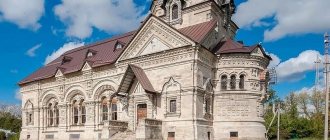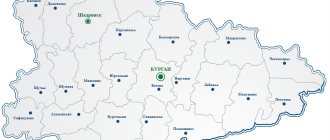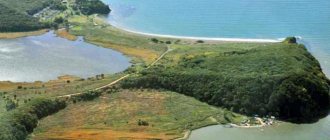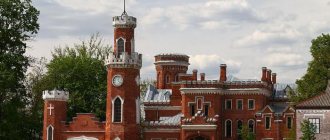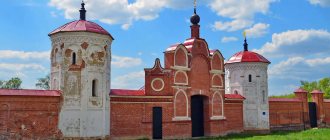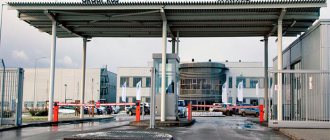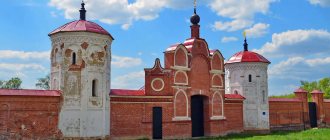In the south-west of the Central part of Russia there is a small subject of the Russian Federation - the Lipetsk region. This is the smallest region in the Central Black Earth economic region of the country. Using a satellite map of the Lipetsk region, you can see that the following areas border the region:
- Ryazan;
- Voronezh;
- Kursk;
- Tambovskaya;
- Tula;
- Orlovskaya.
The region's territories are not very densely populated. This is explained by the fact that in the region a large amount of land is occupied by numerous rivers and reservoirs, most of which belong to the Don basin. The main rivers of the region can be seen on the map of the Lipetsk region by region:
- Voronezh;
- Matyra;
- Beautiful Mecha;
- Standing Cassock;
- Pine.
A number of rivers belong to the Volga basin and are located in the northeastern part of the region. The lands of the region are black earth. Since ancient times, the population living here has been engaged in arable farming and growing agricultural crops.
The formation of the region as a subject of the Russian Federation occurred in the middle of the last century, when several districts around the city of Lipetsk were united. Natural objects, industrial zones, streets, houses and districts on the map of the Lipetsk region can be studied by zooming in and moving around the online service using the mouse.
Districts of the Lipetsk region on the map
The entire territory of the region occupies about 25 thousand km2 and is divided into 18 districts. The largest districts in terms of population and area, which can be viewed using maps of the Lipetsk region with diagrams:
- Gryazinsky;
- Lebedyansky;
- Dobrinsky;
- Lipetsky.
The smallest in area, but densely populated district of the region is Khlevensky. It is located in the south of the region on the border with the Voronezh region. The district includes 16 villages, which, if you zoom in on the map of the Lipetsk region with villages, can be examined in more detail.
Railways and highways pass through the main district of the region - Lipetsk, and domestic air flights are also carried out from the airport, which is located in the suburbs. The direction of highways R-119, R-204, R-205, as well as other highways in the region can be viewed using a detailed road map of the Lipetsk region. It will also help you find the main road junctions, bridges, and bypass roads around cities.
Yelets is a small town
Yelets never aspired to become big. This settlement is specially created for tourists, so local authorities are trying to develop the infrastructure. The authorities are undertaking various programs that are designed to regulate tariff rates for:
- gas;
- water;
- electricity supply;
- housing maintenance;
- improvement of housing stock.
The results generally please the townspeople, who receive playgrounds and landscaped courtyards. Moreover, for this they do not have to overpay significantly, since there are still the same well-thought-out tariffs.
There are practically no traffic jams in the city. However, due to the one-way traffic that prevails here, you may encounter slight congestion. The city has a sufficient number of schools and kindergartens, but many of them are paid. Residents of Yelets are employed in trade enterprises. Nowadays, catering establishments often begin to open in the city. Therefore, there is enough work, but finding employment can be difficult.
Map of the Lipetsk region with cities and villages
The settlements of the Lipetsk region are located close to each other. There are only 2 urban districts - Lipetsk and Yeletsky. Among the cities with a population exceeding 10 thousand people we can note:
- Usman;
- Lebedyan;
- Lipetsk;
- Chaplygin;
- Mud;
- Dankov.
They appeared on the site of former landowner settlements, therefore they have an interesting original history and architectural monuments confirming it. You can learn more about the infrastructure of a city or village, its streets, administrative institutions, and hospitals using a map of the Lipetsk region with settlements.
Attractions of the region are located throughout the territory. Here you can see natural monuments, architectural buildings, military-historical panoramas, ancient industrial and religious sites. Almost every settlement that is marked on the map of the Lipetsk region with cities and villages has its own “calling card”:
- Yelets - Ascension Cathedral of the mid-19th century;
- With. Polibino – hyperboloid mesh tower;
- Lipetsk - Novolipetsk Metallurgical Plant;
- With. Kon-Kolodez - the estate of the Senyavin landowners;
- With. Stanovoe is the largest arboretum in Russia;
- Zadonsk – three active ancient monasteries.
Of particular interest to travelers are the Galichya Mountain reserves, where you can see plants from the pre-glacial period.
According to archaeologists and historians, the territory where the Lipetsk region is currently located has been inhabited since ancient times. Already before the invasion of the Mongol-Tatar army, there were several cities and fortresses in the region: Dobrinsk (now the village of Dobroye, Dobrovsky district). Dubok (village of Dubki, Dankovsky district), Yelets. The Tatar-Mongol yoke brought a lot of grief and suffering to the Lipetsk lands. Cities and villages were destroyed by nomads, and people were driven into slavery. Some of the residents who escaped destruction and slavery fled to the northern and western regions of the country.
The revival of the region began after the expulsion of the Mongol-Tatars. In a very short period of time (late 16th - early 17th centuries), fortified cities were built: Dankov, Talitsky fort, Yeletskaya fortress, Lebedyan. In 1635, the construction of a powerful fortified line for that time began - the Belgorod abatis line, on which the fortresses of Dobry, Sokolsk and Usman stood out within the modern Lipetsk region.
At the end of the 17th and beginning of the 18th centuries, the construction of large enterprises began in the region. The following were built: a water-powered metallurgical plant (on the Bely Kolodez River in 1693), Lipsky ironworks (1700 - 1712), Kuzminsky anchor plant with a weapons assembly workshop (1703 - 1706). The development of agriculture and livestock farming is in full swing, since at that time, with the creation of a regular army and the construction of a navy, the need for flax, hemp, and wool increased.
Worker settlements arose near the factories. One of these working settlements was Lipskaya Sloboda, which on September 16, 1779, by Decree of Catherine II, received the status of a county town with the name Lipetsk. August 16, 1781 - Lipetsk receives a coat of arms with the image of a linden tree in the lower part of the heraldic shield and the coat of arms of the provincial city of Tambov - a beehive and three bees - in the upper part.
In the second half of the 18th century, the growth of large landownership continued, and the black soil strip became the breadbasket of the state.
In 1778 and 1784 master plans for the development of the city of Lipetsk are being drawn up.
By decree of Alexander I, the Lipetsk mineral water resort was opened in 1805, which, according to legend, was discovered by Peter I.
Like the rest of Russia, Lipetsk was affected by the revolution and civil war of 1917, in the fire of which many cultural values were destroyed. The subsequent revolutionary repressions against the church and the “bourgeois past” destroyed the architectural ensembles of noble estates, monasteries, churches, private collections of paintings and literature. Many cultural and artistic figures left their native lands - I.A. Bunin, Stakhovichi.
The widest masses of the population gained access to the riches of domestic and world culture. Even during the years of the Civil War, public libraries and museums began to open on the basis of private collections; reading rooms, amateur theaters, and workers' clubs were created everywhere. In September 1918, the Yeletsk Museum opened. One of the creators was the writer M.M. Prishvin, then teaching in Yelets. Then museums opened in Usman and Zadonsk. In 1920, a music school was opened in Zadonsk, and in 1921, the Lipetsk Theater opened. In 1925, Yelets already had 3 museums, 6 workers' clubs, 9 libraries, a theater and 2 cinemas. In 1938, the first cultural educational institution opened in Zadonsk - now the regional school of culture.
During the Great Patriotic War in 1944, the Lipetsk Tractor Plant (LTZ) was built in record time.
By decree of the Presidium of the Supreme Soviet of the USSR in 1954, the Lipetsk region was formed, which is a subject of the Russian Federation, with the center being the city of Lipetsk.
After the factories were closed in 1975, Lipetsk developed as a resort city due to the presence of mineral waters. Lipetsk resort is the oldest urban resort in Russia.
Economy and industry of the Lipetsk region
The economic potential of the region consists of industry and agriculture. The region is located in the black earth zone, so active crop production is carried out here. In total, there are about 300 agricultural enterprises in the region that grow fruits and berries, grain crops, and breed meat and dairy animals.
Using Yandex maps of the Lipetsk region, you can get an idea of the location of industrial zones in the region. The main enterprises are located in Lipetsk and its vicinity. The diversified industrial complex of the region is represented by such areas as:
- metallurgy;
- mechanical engineering;
- electric power industry;
- light;
- food
On the map of the Lipetsk region you can see in detail where the largest enterprises that produce are located:
- granulated sugar;
- refrigerators and freezers;
- black rolled metal;
- juices;
- pasta;
- steel products.
Construction is also a developed industry. In the Lipetsk region, several hundred thousand square meters of housing are built annually by local construction companies, new facilities appear, roads and bridges are built.
Culture
The most notable architectural monuments of the Lipetsk region include the church in the village of Talitsa (16th - 17th centuries), the 18th century churches in the village of Veshalovka and the village of Troekurovo. In Lebedyan, the buildings of the Trinity Monastery complex (founded in 1621 by order of Patriarch Filaret, the father of Tsar Mikhail Romanov), including the remains of the Trinity Cathedral (1642-1666), heavily destroyed in the late 1920s, as well as Ilyinskaya (early 17th century. ) and Assumption (1621) churches. The ensemble of the Zadonsk Mother of God Monastery with the Assumption Church (1800) and the Vladimir Church, where the relics of one of the greatest saints, Tikhon of Zadonsk, are partially preserved. A large number of estates have been preserved in the region: a manor house in the village of Polibino (1815 - 1825, architects A.L. Vitberg and D.I. Gilardi), where I.E. Repin, K.S. Stanislavsky, N.N. Ge; M.Yu. Lermontov visited his father’s estate Kroptovo several times, I.S. Turgenev visited Lebedyan. In the village of Lev Tolstoy (formerly Astapovo, the place of the writer’s death), a memorial monument to the great writer was erected. Lipetsk region is the birthplace of the Social Democrat G.V. Plekhanov (village of Gudalovka), traveler P.P. Semenov-Tyan-Shansky, writers E.I. Zamyatin (born in Lebedyan), M.M. Prishvina.
Museums in Lipetsk, Yelets, Dankov, Usman, Lebedyan tell about the life of famous natives of the region and the history of the Lipetsk region.
Lebedyan is a beautiful small town
The population is constantly declining; since 2011, there has been an outflow of more than 1,000 people. For the city, the authorities came up with an amazing solution considering the extremely small area.
In 1989, construction of the metro began. The initiator was Leonid Mulyarchik. With the support of local municipalities, he began digging a tunnel, which now reaches only 200 meters. However, experts confirmed that the structure is reliable, but now the metro is officially closed and blocked. Its construction continued until 2011. Lebedyan is characterized by a problem with a shortage of medical personnel, which applies to many settlements in Russia. There is a “Health” program here, but its implementation is at a mediocre level.
Gryazi - industrial town
Mechanical engineering has become a city-forming industry for the city of Gryazi. The settlement plays an important role, being a major railway junction connected with Moscow, Rostov, Orel and Volgograd.
The population is provided with work, but has problems with infrastructure. Housing and communal services require serious improvement measures. The city has kindergartens, private schools, and an art gymnasium. The general situation in Gryazi is typical for any regional city that has a relatively good level of improvement. Young people often leave Gryazi to go to millionaires to look for education and work.
